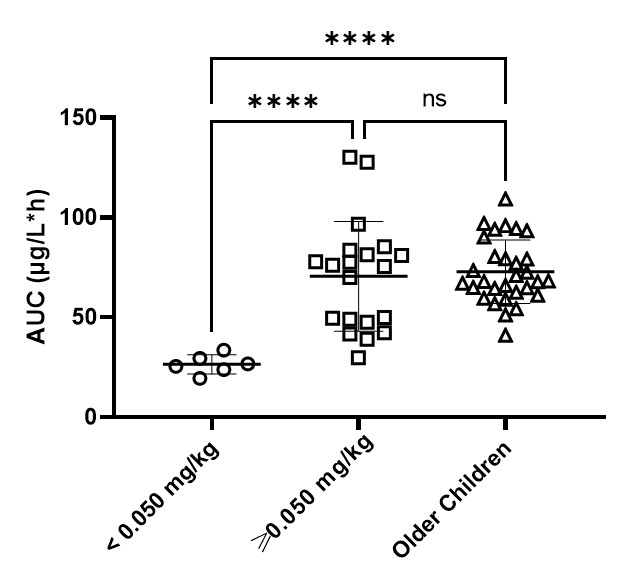B
Grade
Doxorubicin
The PK of doxorubicin has been investigated in infants. A lower CL of doxorubicin has been found in younger patients, however, the number of infants included are low.
Level 1
Population PK model including infants
| Author | Method | Number of Patients/Infants(<1yrs) | Age(yr), Median(range) | Age related findings | ||
|---|---|---|---|---|---|---|
| Völler (2015) | Three compartment popPK model (doxorubicin). One compartment popPK (doxorubicinol). Allometric scaling for BSA. Age was included as covariate on CL of doxorubicin. | 94 / 4 | 5.32 (0.2-17.7) | Age was included as covariate on CL of doxorubicin, indicating a lower CL, corrected for BSA, in younger patients. | ||
| Krischke (2016) | Three compartment popPK model (doxorubicin). One compartment popPK (doxorubicinol). Allometric scaling for BSA. Age was included as covariate on CL of doxorubicin. Age was included as covariate on CL of doxorubicin. | 101 / NS | 5.3 (0.2-17.7) | Age dependence of CL of doxorubicin: <3 years having a statistically significant lower CL than older children after correcting for BSA. |
Level 2
PK model including infants or PopPK model without infants
| Author | Method | Number of Patients/Infants(<1yrs) | Age(yr), Median(range) | Age related findings | ||
|---|---|---|---|---|---|---|
| Thompson (2009) | Three compartment popPK model (doxorubicin). One compartment popPK (doxorubicinol). Allometric scaling for BSA. | 22 / 0 | 15.0 (3.3-21.5) | No correlation between PK parameters and age after adjusting for BSA. | ||
| Köntny (2013) | Three compartment popPK model (doxorubicin). One compartment popPK (doxorubicinol). Allometric scaling for BSA. | 82 / 0 | 21 (3-73) | After adjusting for BSA: No correlation between CL of doxorubicin and doxorubicinol and age. A trend towards a smaller V1 and a larger Vm in younger patients was observed. | ||
| Kunarajah (2017) | Three compartment popPK model (doxorubicin). One compartment popPK (doxorubicinol). Allometric scaling for BSA. Age was included as covariate on CL of doxorubicin. | 17 / 0 | 7.50 (3.4-14.7) | Age was included as covariate on CL, indicating a lower CL, corrected for BSA, in younger patients. |
Level 3
Non-compartmental PK study or PK model without infants
| Author | Method | Number of Patients/Infants(<1yrs) | Age(yr), Median(range) | Age related findings | ||
|---|---|---|---|---|---|---|
| McLeod (1992) | Non-compartmental pharmacokinetics (doxorubicin) | 60 / 4 | NS (0.17-20) | No difference in CL (mL/min/kg) between infants and older children, but there was a trend toward a lower CL (mL/min/m2) in infants compared to older children. | ||
| Eksborg (2000) | Non-compartmental pharmacokinetics (doxorubicin) | 31 / NS | 5.4 (0.73-15.3) | No correlation between age and Cmax after dose normalization for body size. | ||
| Frost (2002) | Non-compartmental pharmacokinetics (doxorubicin and doxorubicinol) | 112 / 5 | 4.7 (for pts >1 yr) (0.3-17.3) | Children 4-6 yrs had the highest dose normalized steady state plasma concentration, followed by children 2-4 yrs, younger and older pts showed similar plasma concentrations. | ||
| Hempel (2002) | Non-compartmental pharmacokinetics (doxorubicin) | 27 / 0 | 4.13 (1.56-19.99) | Age had no effect on Cmax | ||
| Palle (2006) | Non-compartmental pharmacokinetics (doxorubicin) | 37 / 1 | 9.2 (0.63-17.7) | No sign differences in CL (mL/min/m2) between children <2 yrs and older children |
Level 5
Mechanism-based reasoning or expert opinion
| Author | Method | Number of Patients/Infants(<1yrs) | Age(yr), Median(range) | Age related findings | ||
|---|---|---|---|---|---|---|
| Balis (2017) | Mechanism-based development of dose bands based on BSA intervals | |||||
| Siebel (2020) | Pharmacokinetic simulations using the popPK model of Völler (2015). | 94 / 4 | 5.32 (0.2-17.7) | Conclusions: treatment strategies for young children should adapt both the dose (based on age and BSA) and the duration of infusion. |


